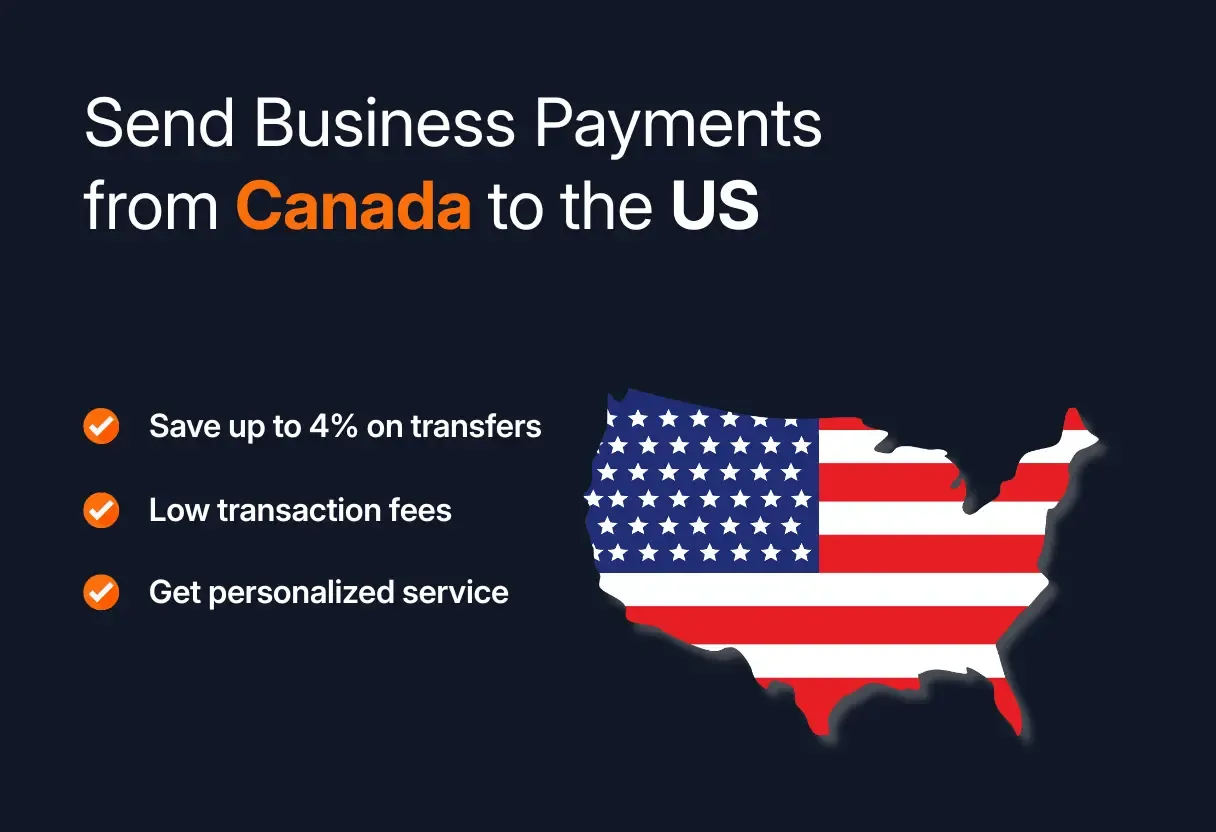Send Business Payments from Canada to the US
Canadian businesses often need to send payments to US partners for trade, payroll, and investments. This guide outlines costs, compliance requirements, and the impact of the CAD to USD exchange rate, while showing how MTFX makes transfers faster, transparent, and more cost-effective.
The United States is Canada’s largest trading partner, with nearly 75.9% of Canada’s domestic exports went to the United States in 2024. With such strong economic ties, Canadian companies often need to send business payments to the US for supplier invoices, payroll, or cross-border investments.
Whether you’re a small business expanding into the American market or a large corporation with recurring obligations, knowing how to make cross border business payments efficiently can protect profit margins, improve supplier relationships, and ensure compliance.
Why Canadian companies send business payments to the US
Canada and the US share the world’s second-largest bilateral trading relationship. In 2024 alone, the two nations exchanged $909.1 billion in goods and services. This massive trade flow creates constant demand for corporate cross border payments from Canada to the US. Common reasons businesses transfer funds from Canada to the US:
- Pay US suppliers from Canada
Many Canadian manufacturers, retailers, and distributors rely on American suppliers for raw materials, machinery, and consumer goods.
- Cover service contracts and licensing fees
From software subscriptions to professional services, Canadian businesses frequently settle invoices with US service providers.
- Handle payroll and contractor payments
Remote and hybrid work arrangements mean Canadian firms often have US-based staff or freelancers who must be paid in USD.
- Fund subsidiaries or partnerships
Expanding into the US requires ongoing funding for operating costs, marketing, and compliance.
- Support cross-border investments
Businesses transfer funds for real estate purchases, joint ventures, or intercompany loans.
No matter the purpose, selecting the right channel for business money transfers directly impacts speed, transparency, and cost.

Understanding the CAD to USD exchange rate for businesses
Why exchange rates matter
The CAD to USD exchange rate for businesses determines how much your American counterpart actually receives. Even small fluctuations can make a large difference:
- At 1 CAD = 0.735 USD, sending CAD 100,000 equals USD 73,500.
- At 1 CAD = 0.746 USD, that same CAD 100,000 becomes USD 74,600.
That’s a USD 1,100 swing from just a minor shift in the rate.
Who sets the exchange rate?
- The Bank of Canada publishes official daily rates, but these are benchmarks, not what businesses actually receive.
- Banks and providers apply spreads (markups) that can significantly alter the effective rate.
- Larger transactions often secure tighter spreads, while smaller payments face higher margins.
Currency volatility
The CAD to USD rate is influenced by:
- Oil prices (Canada is a major exporter)
- Interest rate policies by the Bank of Canada and US Federal Reserve
- Trade balances and economic data on both sides of the border
Businesses handling frequent cross border business payments should monitor the rate daily and consider hedging strategies to protect margins.
See today’s rate in action:
Use the converter below to check how much your CAD amount translates into USD at the live rate. Even a small shift in decimals can change how much your US partner receives.
The costs of sending business payments abroad from Canada
When Canadian companies send business payments abroad from Canada, costs extend beyond the visible exchange rate. Understanding each factor helps avoid surprises and keeps corporate cross border payments from Canada to US efficient.
FX conversion spreads
One of the largest hidden costs in business money transfers comes from the foreign exchange spread. This is the markup banks and providers apply to the CAD to USD exchange rate for businesses. Even a 2% spread can add thousands in costs for a single large payment. Unlike transaction fees, spreads are less visible, which is why it’s essential to compare providers and negotiate better rates whenever possible.
Wire transfer fees
Traditional banks typically charge fixed fees for cross-border transfers, often in the range of CAD 30–50 per transaction. While this may not sound significant, the cost adds up for businesses making multiple payments each month. These charges also apply regardless of the transfer amount, making them especially inefficient for small or recurring payments. For firms that regularly send business payments to US suppliers, exploring low-fee alternatives can result in significant long-term savings.
Intermediary bank fees
Many cross-border wires are routed through intermediary or correspondent banks before reaching the final US recipient. These institutions may deduct USD 10–30 or more from the payment, often without warning to the sender. This means your supplier may receive less than expected, creating reconciliation issues or strained relationships. Because these fees are deducted mid-route, Canadian businesses have little control over them. Using providers that avoid unnecessary intermediaries is one way to reduce these deductions.
Processing delays
Payment speed is critical when managing corporate cross border payments from Canada to US. Traditional wires can take one to three business days, and any errors in account or routing details can cause additional delays. During this time, funds are in transit and unavailable to either party, which creates working capital challenges. In competitive supply chains, late payments can damage credibility and disrupt delivery schedules. Faster settlement methods reduce the “float” cost and ensure US partners receive funds when expected.
Reconciliation overhead
Every payment must be matched against invoices, but hidden spreads, intermediary deductions, and unexpected delays complicate reconciliation. Accounting teams may spend valuable time confirming final received amounts, chasing missing funds, and updating records. This administrative burden can be costly, especially for firms making frequent business payments to US. Choosing transparent providers with detailed reporting tools reduces reconciliation time, streamlines financial operations, and gives finance teams better control over cross-border cash flow.
Why it matters
For businesses executing frequent corporate cross border payments from Canada to the US, these costs compound quickly. Using providers, like MTFX, with transparent pricing and competitive FX rates helps lower the true cost of business money transfers.
Regulatory, legal & compliance considerations
When Canadian businesses make business payments to US entities, regulatory and legal compliance is essential. Take a look why your money transaction should cater to these laws.
FINTRAC / Canada’s AML / reporting rules
Canadian institutions must report all cross-border electronic funds transfers of CAD 10,000 or more to the Financial Transactions and Reports Analysis Centre of Canada (FINTRAC). These rules exist to prevent money laundering and terrorism financing. Businesses must ensure every large corporate cross border payment from Canada to US meets reporting thresholds to avoid delays, scrutiny, or potential penalties.
KYC / AML / sanctions screening
Know Your Customer (KYC) and Anti-Money Laundering (AML) checks are mandatory in both Canada and the US. Banks and payment providers are required to verify the identity of both senders and recipients, screen for politically exposed persons, and monitor for unusual patterns. Sanctions screening ensures no party is restricted under global or US lists, such as OFAC. Compliance keeps business money transfers both secure and legally valid.
US regulatory oversight
On the US side, payments fall under strict regulatory regimes enforced by the Federal Reserve, the Office of Foreign Assets Control (OFAC), and other federal agencies. Financial institutions must comply with AML laws, sanctions programs, and internal monitoring systems. Canadian businesses sending business payments to US partners should ensure their providers maintain compliance with both US and Canadian rules to avoid blocked or frozen transfers.
Transfer pricing / tax documentation
When payments are made between affiliated entities in Canada and the US, transfer pricing rules apply. Both the Canada Revenue Agency (CRA) and the US Internal Revenue Service (IRS) require documentation proving that intercompany payments are conducted at “arm’s length.” This ensures proper taxation and prevents profit shifting. Without adequate documentation, businesses face audits, penalties, or double taxation on corporate international business payments from Canada to US.
Records retention
Both Canadian and US jurisdictions require businesses to retain payment documentation for several years, typically five or more. This includes invoices, payment confirmations, contracts, and compliance reports. Maintaining organized records not only satisfies regulatory requirements but also supports internal audits and dispute resolution. Reliable record-keeping ensures that business money transfers remain traceable and compliant, reducing the risk of penalties or reputational harm.
Managing currency risk and exchange rate strategy
Because of volatility in the CAD to USD exchange rate for businesses, risk management is crucial.
Forward contracts
Forward contracts allow businesses to lock in today’s exchange rate for a payment scheduled in the future. This removes uncertainty from budgeting and forecasting, ensuring that currency swings won’t erode margins. For Canadian firms making regular business payments to US suppliers, forwards provide predictability, making them especially useful for long-term contracts and recurring obligations where stability is more important than chasing short-term rate gains.
Holding USD balances
Maintaining a USD-denominated account in Canada enables businesses to store and use US dollars without converting every time. This is particularly useful for firms with recurring obligations like payroll or supplier invoices. By holding USD balances, businesses can convert at favourable times, reducing exposure to rate volatility. It also speeds up payments since no conversion step is needed, streamlining business money transfers to US partners.
Rate alerts
Rate alerts help businesses monitor exchange movements and act when the CAD/USD rate hits preferred levels. Some providers also offer rate band tools, allowing automatic execution of payments within a set threshold. This reduces the risk of missing favourable moves while keeping transfers predictable. By using these tools, Canadian firms making business payments to US can optimize timing and avoid last-minute, costly conversions.
Speed, reliability & efficiency in transfer options
When Canadians send business payments from Canada to the US, speed and reliability can be as important as cost. Traditional wire transfers through banks may take two to three business days, especially if routed through intermediary banks. Delays not only affect cash flow but can also strain supplier relationships. On the other hand, specialized FX providers like MTFX often offer same-day or next-day settlement, with clearer tracking and fewer deductions. Efficiency also matters: automated payment systems, integration with accounting platforms, and detailed reporting reduce administrative workload, making corporate cross border payments from Canada to US smoother and more transparent.
Options for business money transfers to the US
Canadian companies have several ways to send business payments from Canada to the US, but not all are created equal. Each method comes with its own strengths and weaknesses, and the right choice depends on how often you transfer, the amounts involved, and your tolerance for cost and risk.
Bank transfers
Traditional bank transfers remain one of the most common ways businesses move money across the border. Banks are trusted and universally recognized, which makes them a familiar option for companies looking to pay US suppliers from Canada or for other purposes. This reliability provides peace of mind, especially for first-time transactions or when dealing with new partners in the United States.
However, the trade-off is that bank transfers are expensive and slow. Settlement can take one to three business days, and intermediary banks may deduct unexpected fees before the funds arrive. In addition, Canadian banks often apply wide spreads on the CAD to USD exchange rate for businesses, inflating the true cost of corporate payments and making bank transfers less efficient for frequent payers.
Specialized online FX providers
Specialized online FX providers have become the preferred choice for many Canadian businesses that frequently need to send business payments to US partners. These platforms focus exclusively on cross-border transfers, offering lower spreads, faster settlement times, and transparent pricing. Businesses gain the ability to track payments in real time and avoid the hidden deductions common in traditional banking channels.
This is where MTFX stands out as a leading provider. Regulated by FINTRAC and backed by over 25 years of experience, MTFX delivers competitive exchange rates, reduced transfer fees, and settlement within a day for CAD to USD transfers. Companies can pay US suppliers, remote workers, or contractors from Canada quickly while maintaining visibility and control. For firms managing regular corporate cross border payments from Canada to the US, MTFX also offers multi-currency accounts, automation tools, and FX risk management solutions, making it a smarter and more cost-effective choice than banks.

The future of Canada to US business payments
The future of corporate cross border payments from Canada to the US is about speed, transparency, and control — all areas where MTFX already provides advanced solutions. Businesses can expect faster settlement times, bank-beating CAD to USD exchange rates for businesses, and the ability to hold funds in multi-currency accounts to reduce repeated conversions.
Looking ahead, automation and digital tools will continue to shape cross border business payments. With MTFX, companies already have access to features like rate alerts, integrated payment platforms, and detailed reporting dashboards. These innovations point to a future where Canadian businesses move money to the US more efficiently, with lower costs and greater visibility.
Driving growth through smarter cross-border payments
As Canada’s closest trading partner, the United States will remain a critical market for Canadian companies. Managing corporate cross border payments from Canada to the US effectively means more than just moving money - it’s about protecting margins, staying compliant, and ensuring financial efficiency. Businesses that adopt faster, transparent, and cost-effective solutions will be better positioned to compete and grow in this integrated market.
Partner with MTFX to unlock bank-beating CAD to USD exchange rates for businesses, faster settlement, and powerful digital tools that simplify global payments. Get started today and transform the way you move money across borders.
FAQs
1. What are the common reasons for Canadian businesses to make business payments to the US companies?
Canadian firms often make business payments to US suppliers, contractors, and subsidiaries for goods, services, payroll, and investments.
2. How do business money transfers from Canada to the US typically work?
Business money transfers involve converting CAD to USD, selecting a transfer method, and sending funds through banking networks or specialist providers.
3. How does the CAD to USD exchange rate for businesses affect payments?
The CAD to USD exchange rate for businesses directly impacts how much the US recipient receives. Even small rate changes can alter final amounts significantly.
4. What are the main costs of corporate cross border payments from Canada to the US?
Costs include FX spreads, wire fees, intermediary deductions, and reconciliation overhead. These can be reduced by using specialized providers.
5. How can Canadian companies pay US suppliers from Canada efficiently?
Companies can pay US suppliers from Canada through FX providers like MTFX offering competitive rates.
6. Are specialized FX providers better than banks for business money transfers?
Yes. Specialist providers offer lower FX spreads, transparent fees, and faster settlement compared to traditional banks for business money transfers.
7. How long do cross border business payments to the US take?
Bank wires may take 1–3 business days, while MTFX help you transfer in a day so that you can pay your suppliers, remoter workers, or contractors on time.
8. Can I protect my business from CAD to USD exchange rate fluctuations?
Yes. Tools like forward contracts, rate alerts, and multi-currency accounts help manage volatility in the CAD to USD exchange rate for businesses. MTFX offers you these risk management tools so that your business do not have to face any loss.
9. Why are multi-currency accounts useful for business money transfers?
Multi-currency accounts let firms hold USD balances, reducing conversion costs and improving efficiency for business money transfers.
10. How can MTFX help with corporate cross border payments from Canada to the US?
MTFX offers competitive CAD to USD exchange rates for businesses, automated platforms, rate alerts, and faster settlement options for corporate international transfers from Canada to the US.
Partner with MTFX to unlock bank-beating CAD to USD exchange rates for businesses, faster settlement, and powerful digital tools that simplify global payments. Get started today and transform the way you move money across borders.
Sources
https://www.statcan.gc.ca/en/topics-start/canada-united-states/trade
https://ustr.gov/countries-regions/americas/canada?
https://www.federalreserve.gov/
Related Blogs
Stay ahead with fresh perspectives, expert tips, and inspiring stories.

Keep updated
Make informed decisions
Access tools to help you track, manage, and simplify your global payments.
Currency market updates
Track key currency movements and plan your transfers with confidence.
Create an account today
Start today, and let us take the hassle out of overseas transfers.
